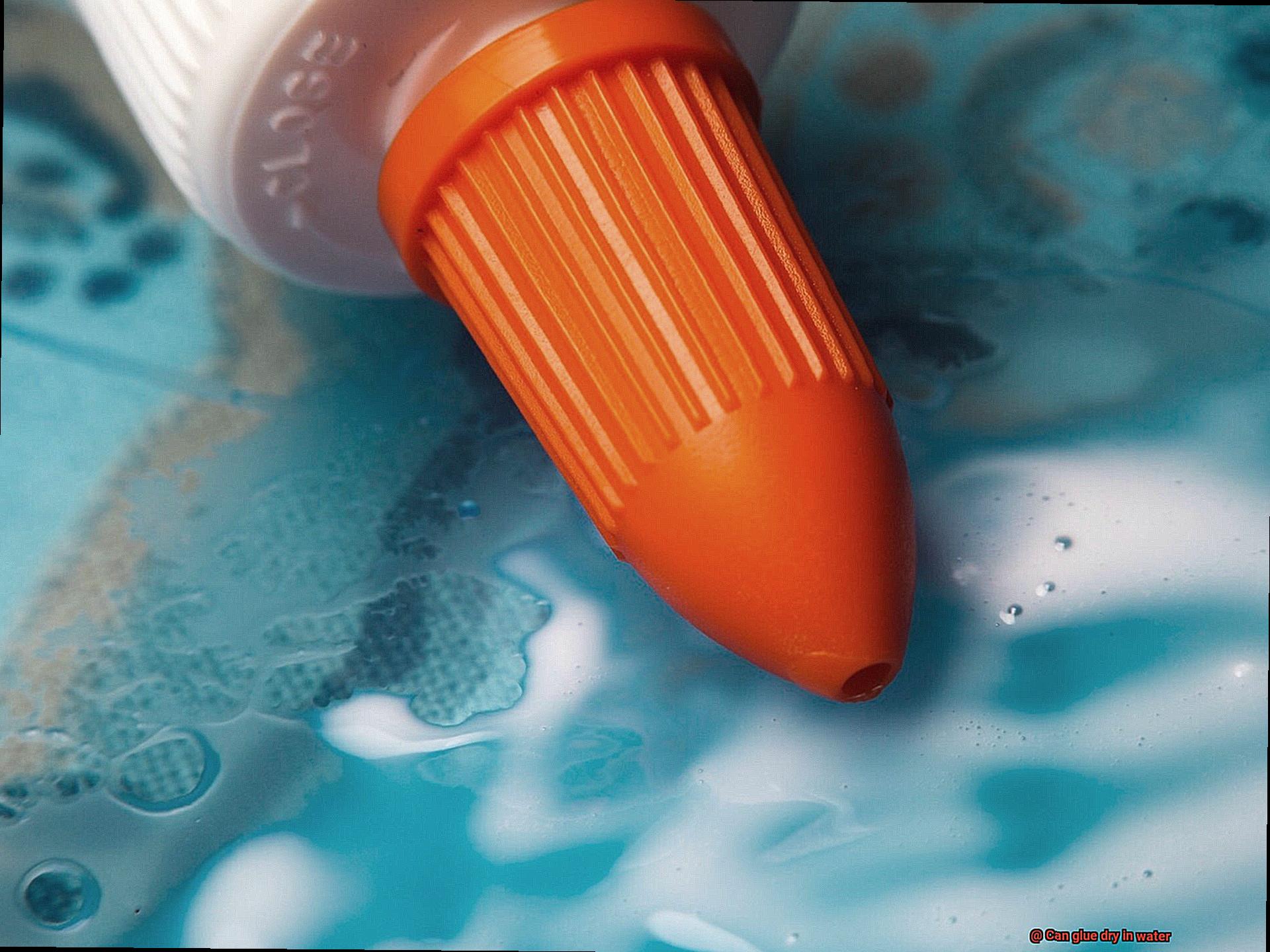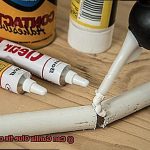Are you tired of constantly battling water damage and trying to find the right adhesive to fix your underwater mess? Well, fear not. The age-old saying that “water and glue don’t mix” is not entirely true. The question on everyone’s minds is, can glue dry in water? And the answer may surprise you.
Glue is a versatile household item used to bond materials together. However, when it comes to underwater repairs, many assume that glue is not an option. But what if I told you that there are actually types of glue that can dry underwater? From epoxy to silicone, some adhesives have the ability to bond and harden in wet environments.
Before diving into any DIY projects involving underwater repairs with glue, it’s important to understand which adhesives are suitable for this task. Some glues may dissolve or weaken in water, making them unsuitable for any underwater application. Additionally, factors such as temperature, pressure, and the type of material being bonded also play a role in choosing the right adhesive.
In this blog post, we will explore the world of glue and answer the burning question: can glue really dry in water? We’ll dive deep into the different types of adhesives available and discuss their properties, applications, and suitability for underwater repairs. So whether you’re dealing with a leaky pool or a broken aquarium, keep reading to discover which glue is right for you.
Types of Glue
Contents

Glue, an adhesive that helps us bond materials together, comes in various types, each with its unique properties and uses. While some types of glue dissolve in water, others resist water exposure. In this article, we will delve into the different types of glue available in the market and their ability to dry in water.
PVA Glue:
PVA glue, also known as white glue or school glue, is a water-soluble adhesive that is ideal for paper, cardboard, and wood projects. It dries clear and can be thinned with water to suit delicate projects. However, PVA glue dissolves in water, making it unsuitable for projects that may be exposed to water.
Superglue:
Cyanoacrylate glue, commonly known as superglue, is a fast-drying adhesive that bonds quickly and strongly to various materials such as metal, plastic, and wood. Superglue is water-resistant and can even cure underwater, making it ideal for projects exposed to moisture.
Epoxy Glue:
Epoxy glue is a two-part adhesive consisting of a resin and a hardener. When mixed together, these components create a strong bond that is resistant to water, heat, and chemicals. Epoxy glue is ideal for bonding materials such as metal, glass, and plastic.
Wood Glue:
Wood glue creates a strong bond between wood pieces and dries clear, making it perfect for woodworking projects. While not waterproof, wood glue can resist moisture to some extent.
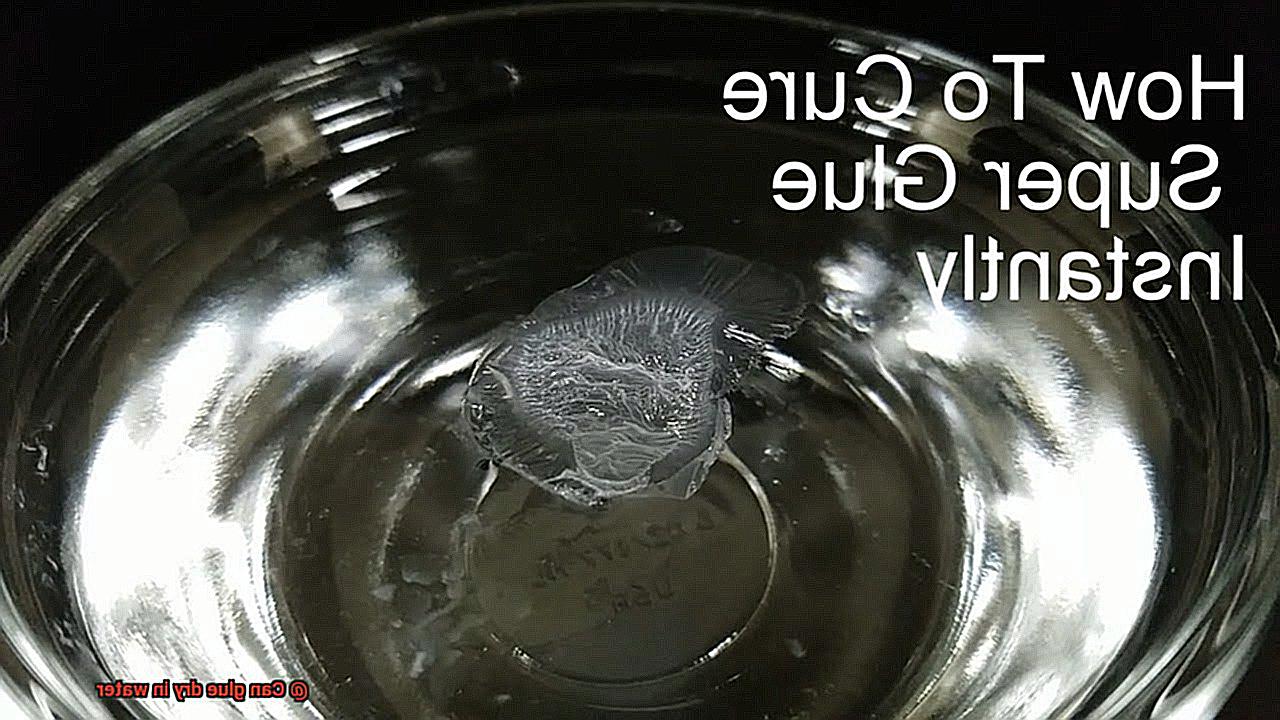
Fabric Glue:
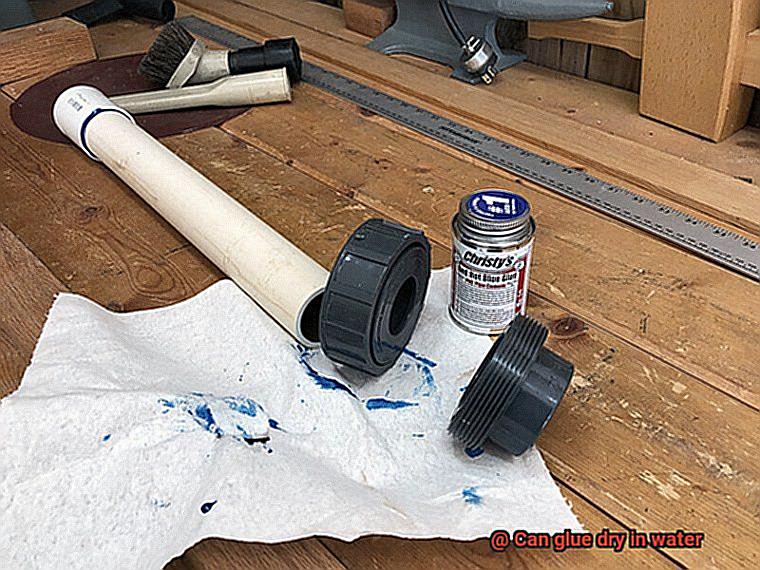
Fabric glue is specially formulated for use with fabrics and textiles. While not waterproof, fabric glue can resist moisture to some extent.
Hot Glue:
Hot glue is a versatile adhesive used with a hot glue gun. It dries quickly and creates a strong bond between materials such as fabric, foam, and plastic. However, hot glue is not waterproof and breaks down when exposed to water.
In conclusion, the ability of glue to dry in water depends on the type of adhesive used. It is essential to choose a water-resistant or waterproof adhesive for projects that may be exposed to moisture.
Does Glue Dry in Water?
When it comes to the question of whether glue can dry in water, the answer is not a straightforward one. It all depends on the type of glue being used. So, let’s dive into the world of adhesives and explore the different types and how they react to water.
Firstly, let’s talk about water-soluble glues, such as PVA glue or white school glue. These types of glues can indeed dry in water as they dissolve in water. When exposed to water, the glue molecules break down, causing them to lose their adhesive properties and become liquid again. However, this also means that continued exposure to moisture can cause the bond to weaken over time.
On the other hand, non-water-soluble glues like superglue and epoxy do not dry in water. In fact, they are designed to bond with surfaces even when exposed to moisture. Superglue and epoxy actually harden when they come into contact with moisture, making them an excellent choice for projects that will be exposed to water regularly. The moisture actually helps them form an even stronger bond.
It’s important to note that even if a glue can dry in water, it might not be the best option for your project. If you’re working on something that will be exposed to moisture frequently or for extended periods of time, it’s best to opt for a waterproof or water-resistant adhesive specifically designed for those conditions.
PVA (Polyvinyl Acetate) Glue
This versatile adhesive is a popular choice for a variety of projects, including paper crafts, woodworking, and bookbinding. But have you ever wondered if PVA glue can dry in water? As an expert on the subject, I’m here to provide you with some vital information about this fascinating adhesive.
Polyvinyl acetate (PVA) glue is a water-based adhesive that dries clear and creates a strong bond. However, many people are concerned about whether it can withstand exposure to water. The answer is yes and no. PVA glue can dry in water, but it depends on the amount of water and the duration of exposure. If the glue is fully cured before it comes into contact with water, it will not dissolve or become undone. However, if the glue is still wet or partially cured when it gets wet, it can soften or dissolve.
So how does PVA glue work? The glue is made up of polymer chains that crosslink when exposed to air. As the glue dries, the polymer chains bond together to create a strong adhesive. When exposed to water, the polymer chains can break apart, causing the glue to weaken or dissolve.
To prevent PVA glue from drying in water, it’s crucial to ensure that the glue is fully cured before exposing it to moisture. Depending on the brand and type of PVA glue used, curing time can range from a few hours to 24 hours. It’s also essential to avoid getting your project wet until the glue has entirely dried.
Here are some additional tips for achieving strong and reliable bonds with your PVA glue:
- Ensure that the surfaces you’re gluing are clean and dry before applying the glue.
- Apply a thin layer of glue evenly to one surface.
- Press the surfaces together firmly and hold them in place for a few minutes.
- Allow the glue to dry entirely before handling your project.

By following these simple guidelines, you can get the most out of your PVA glue and avoid any mishaps with water exposure.
Epoxy and Cyanoacrylate (Super Glue)
As an expert in adhesives, I’m here to share the differences between these two types of adhesives and help you choose the best one for your project.
Epoxy is a two-part adhesive that consists of a resin and hardener. When mixed together, the adhesive hardens and cures quickly. It’s known for its strong bonding properties and can be used on various materials such as metal, wood, concrete, and plastic.
While epoxy isn’t completely waterproof, it can withstand some exposure to water without losing its bonding strength. However, prolonged exposure to water can cause the adhesive to weaken over time.

If you’re looking for a quick fix, cyanoacrylate or Super Glue may be your go-to adhesive. This fast-drying adhesive is ideal for small repairs and bonding tasks. Although it bonds quickly in wet conditions, it may not hold up well over time. Exposure to water can cause the adhesive to break down and lose its bonding strength.
Choosing the right adhesive depends on your specific needs and the environment in which it will be used. If you need a strong adhesive for a long-lasting repair, epoxy is your best bet. But if you need a quick fix and don’t anticipate exposure to water, cyanoacrylate may be the perfect solution.
When using adhesives in wet or humid conditions, it’s vital to take precautions. Follow the instructions carefully and allow sufficient time for the adhesive to cure before exposing it to water.
Saltwater and Adhesives
When it comes to adhesives and water, choosing the right adhesive for your environment is crucial. Saltwater, in particular, can pose a challenge for certain types of adhesives due to its corrosive nature. The higher levels of dissolved salts in saltwater can react with the chemicals in some adhesives, causing them to weaken and lose their bond strength.
But fear not, not all adhesives are created equal when it comes to saltwater resistance. Some industrial-strength adhesives are specifically designed to withstand exposure to saltwater and other harsh conditions. These adhesives contain special chemical compounds that prevent saltwater from breaking down their bonds or causing them to dry slowly.
Marine-grade epoxy is a prime example of an adhesive that can withstand exposure to saltwater and other harsh marine environments. It’s a popular choice for boat building and repair due to its unique chemical composition that enhances its resistance to moisture, including saltwater. Even when submerged in water, marine-grade epoxy remains reliable and long-lasting.
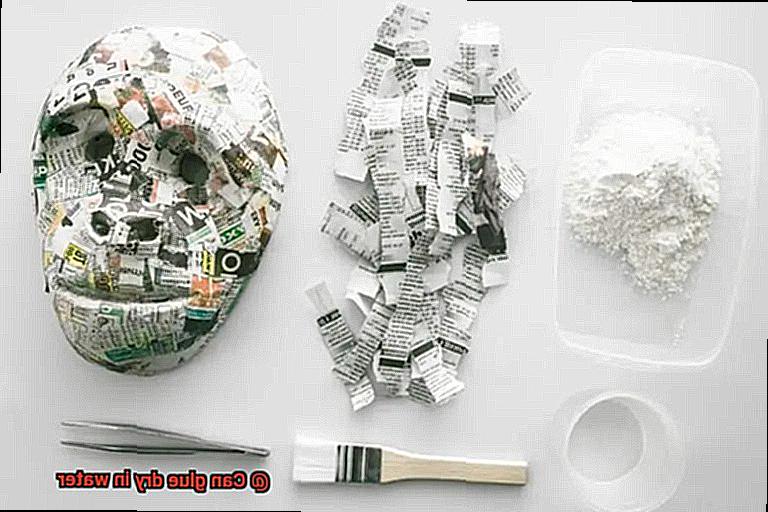
It’s important to note that not all adhesives are suitable for use in saltwater environments. Some may dry too slowly or not at all in the presence of saltwater, while others may quickly lose their bond strength. Always check the manufacturer’s specifications before using any adhesive in a marine or saltwater environment to ensure that it will perform as expected.
Factors That Affect the Ability of Glue to Dry in Water
Then, understanding the factors that affect the ability of glue to dry in water is essential.
First and foremost, the type of glue used is crucial. Some types of glue are designed to dry in water, such as PVA (polyvinyl acetate) glue or marine-grade epoxy. However, other types like standard wood glue or white school glue are not waterproof and will not adhere well when exposed to water.
Another critical factor is the amount of water present. Too much water can affect the glue’s ability to dry effectively. It is best to keep the surface as dry as possible and avoid using glue on soaking wet surfaces. If you must use glue on a wet surface, use waterproof glue for optimal results.
Temperature and humidity levels play a significant role in the drying process. High humidity can slow down the drying process, while high temperatures can speed it up. Following the manufacturer’s instructions on temperature and humidity levels is crucial for optimal results.
The surface where the glue is applied also affects its ability to dry in water. Porous surfaces like wood or paper may take longer for the glue to dry than non-porous surfaces like metal or plastic. It is essential to consider the surface before applying glue and choose an adhesive that works well with that surface.
Lastly, the thickness of the glue layer impacts its ability to dry in water. A thin layer will dry faster than a thick one. Therefore, it is best to apply just enough glue for your project.
How to Choose the Right Glue for Projects Exposed to Water
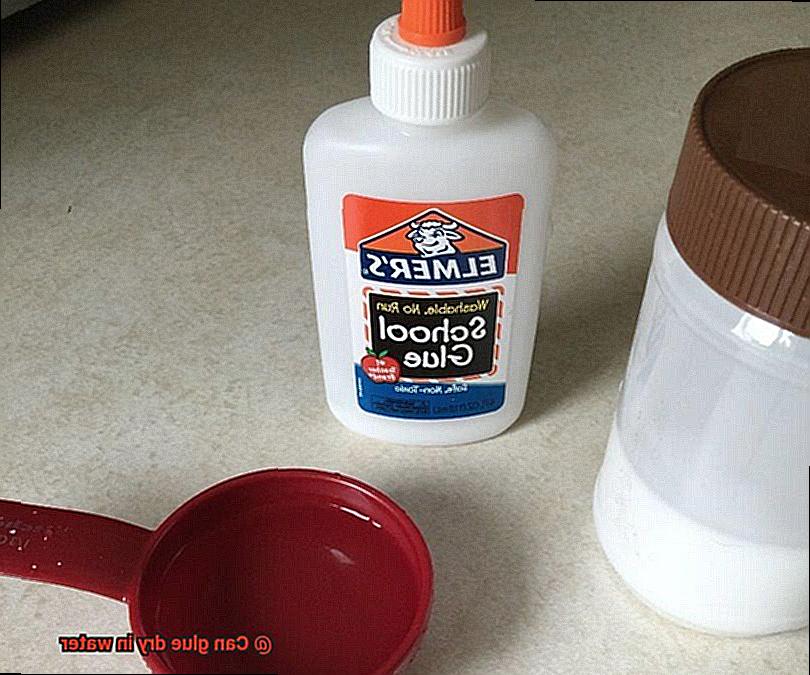
When it comes to projects that will be exposed to water, choosing the right glue is crucial. Failure to select the appropriate adhesive can result in a ruined project or damaged item. To help you make an informed decision, here are five factors to consider when choosing the right glue for water-exposure projects.
Water-resistance
The first and most important factor to consider is water-resistance. Choosing an adhesive that has been specifically formulated to withstand exposure to water is essential. Look for products labeled as “waterproof” or “water-resistant.” These types of glues are designed to hold up well in wet conditions and are less likely to break down or lose their adhesive properties when exposed to moisture.
Material compatibility
Different adhesives work better on certain materials than others. It’s essential to choose an adhesive that is compatible with the type of material you will be bonding.
For example, cyanoacrylate glue (also known as super glue) is excellent for bonding non-porous surfaces like metal and plastic, but may not work as well on porous materials like wood or fabric. In those cases, a different type of adhesive, such as epoxy or polyurethane glue, may be a better choice.
Exposure conditions
The specific conditions your project will be exposed to can impact the effectiveness of different types of glues. Will it be fully submerged in water or just exposed to dampness or humidity? Will it be exposed to saltwater or freshwater? It’s important to choose a product that is specifically designed for your particular application.
Application method
Different adhesives require different application methods. Some adhesives require mixing before use, while others come in a spray or brush-on form. It’s essential to choose an adhesive that is easy for you to apply and suits your project’s needs.
Strength and durability
Consider the strength and durability of the adhesive you choose. Will it hold up under constant exposure to water, or will it break down over time? Consider the weight and stress on the bond as well. For heavier items, a stronger adhesive will be necessary.
TfwGWYIFymE” >
Also Read: Is Super Glue Waterproof? – Glue Things
Conclusion
In conclusion, the notion that water and glue don’t mix is not entirely accurate. While some adhesives may falter in water, others have the power to bond and solidify in damp conditions. When it comes to selecting the appropriate adhesive for underwater repairs, it’s critical to weigh factors such as water-resistance, material compatibility, exposure conditions, application method, and strength and durability.
From PVA glue to epoxy and cyanoacrylate (super glue), each adhesive type boasts unique properties and applications. PVA glue is perfect for paper crafts and woodworking but dissolves when exposed to water. Epoxy is a two-part adhesive that creates a robust bond resistant to water, heat, and chemicals. Cyanoacrylate dries quickly but might not hold up well over time when submerged.
When using adhesives in wet or humid environments, it’s vital to adhere strictly to the manufacturer’s instructions and allow ample time for curing before exposing them to water. Opting for an industrial-strength adhesive specifically crafted to endure saltwater exposure can also prevent bond weakening or loss of strength.

